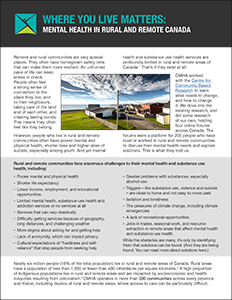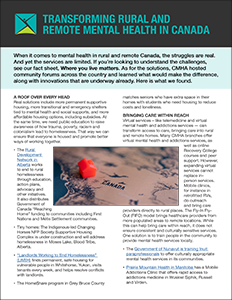Menu
Close
Mental Health in Rural and Remote Canada: Community insights and solutions
May 20, 2025
Remote and rural communities are special places. They’re known for strong social bonds, close ties to the land, and a pace of life that can help keep stress at bay. Many people in these communities take pride in looking out for one another, and in their homegrown support systems that foster a deep sense of belonging.
But life in these communities also comes with challenges—especially when it comes to health. People living in rural and remote areas often face poorer mental and physical health outcomes, shorter lifespans, and alarmingly high rates of suicide, particularly among youth. And yet, services for mental health and substance use health are profoundly limited—if such services exist at all.
There are not a lot of doctors. There are not a lot of psychiatrists. There are not a lot of counselors.
Alana, rural PEI
If only mental health care were available virtually.
Kristen, rural Labrador
People in rural communities face challenges unique to rural areas, such as stigma and limited access to mental health services. Tailored solutions in community and improved access to mental health services are priorities for rural and remote communities.
Jessica, CMHA Alberta
The Canadian Mental Health Association (CMHA) set out to understand what’s needed—and what’s possible. With support from West Fraser, a Canadian wood products company that operates primarily in rural communities, we reviewed existing studies of the mental health needs of rural and remote communities. We also conducted our own research including four national online forums with people who live and work in rural and remote communities.
Here’s some of what they told us:
- Virtual services transform care, but on their own are not enough.
- Mobile clinics in retrofitted RVs bring care close to home.
- Posting QR codes at stores and gas stations is a fresh way to share mental health resources.
- Training local paraprofessionals and peer supporters expands the mental health workforce.
Explore more insights and solutions in these fact sheets:


